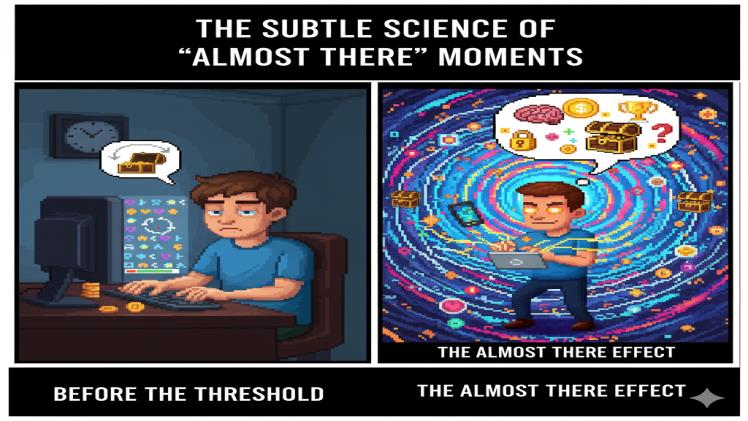Have you ever turned a digital reel or done a level in a game on your phone and had that acute pang of so near, yet so far? The temporary feeling–when victory is within reach, yet out of reach–is not frustration at all. It is its advanced combination of psychology, neuroscience, and online design that keeps our eyes on the screen, encourages us, and, in some cases, even obsesses us. And in the online gaming and mobile casino applications sphere, this is the near-miss moment of action—and learning about it can help explain why mobile apps such as Dragon Slots Poland attract millions of users.
Contents
Experiencing the Near-Miss: The Emotional attraction.
It is the near-miss effect, commonly referred to as the ‘almost there’ moment, and it is deceptively simple. You are playing a game or using a digital application, and in a moment, you believe you can succeed. The curious paradox here has long been observed by psychologists: a narrow escape can be more inspirational than a victory. The combination of aggravation and optimism makes it an interesting emotional cocktail that makes us play, check, or spin.
This is strongly associated with cognitive bias. The wiring of our brains is such that we see near-misses as indications that we are about to win, even though the probability has not changed. Add to that the loop of instant gratification in mobile applications, and you have a formula for extreme engagement.
The Psychology of Almost There.
Why, then, is it so powerful to have nearly won? There are two major working mechanisms:
Anticipation and Reward Loops.
The dopamine loop is, in practice, the illusion of closeness that your brain celebrates, and this generates a motivating itch to give it another go.
Cognitive Bias and Behavioural Patterns.
Near-misses also take advantage of such behavioural patterns as the illusion of control, which is the belief that by putting in a little more effort, one is doomed to success. All this is compounded with decision fatigue, how repetitive digital exchanges burn out self-control and what you have is a powerful mixture that keeps users active well beyond the original thrill.
Neuroscience: What is Going on in the Brain?
Neuroscientists have traced several brain areas which respond hyper-aggressively to near-misses:
| Brain Region | Function | Role in Near-Miss Effect |
| Striatum | Reward processing | Reacts to near-misses almost as strongly as to wins |
| Insula | Emotional awareness | Registers frustration and motivation to try again |
| Prefrontal Cortex | Decision-making | Balances impulse and control; often overridden by excitement |
| Amygdala | Emotional memory | Stores emotional charge linked to near-miss experiences |
These encounters explain why such a near miss feels so lifelike. The mechanism behind this prediction error —here, the brain anticipates a reward and thus modifies its behaviour when the outcome is not precisely what it anticipated. This change is both frustrating and incentivizing —a minor push that maintains high digital engagement.
Digital Design: Creating the Near-Win.
The physical slots near-miss effect on the online platform and the mobile casino app is now played on the virtual screens. The subtle science in platforms such as Dragon Slots Poland allows for creating an experience that feels too close to victory.
From Slots to Screens
The mechanics of near-misses have moved beyond conventional casinos and into mobile applications. Sound cues, animations, and variable rewards are created to evoke that same familiar thrill of almost there. The result? Players are entertained, fascinated, and encouraged to play again—they usually do not even know that an advanced design of behaviour is at work.
Beyond Gambling
The laws of near-miss are not restricted to gambling. Many casual games, fitness applications and social platforms borrow the same psychological hooks. It is this combination of reward anticipation, immediate response, and incremental growth that creates a digital engagement environment. The near-miss effect can be seen even in non-gaming apps, where it can be subtle and influence users’ behaviour, choices, and returns.
Professional Evaluation: Playing with Psychology.
According to behavioural scientists, the near-miss effect is an example of the strengths and dangers of engagement design. On the one hand, it can improve the user experience and make interactions more fun; on the other hand, it can emphasize the boundary between fun and addiction. Ethical designers and platforms should strike the right balance between instant-gratification systems and openness and user control, so that digital interactions enhance the experience rather than take advantage of behavioural weaknesses.
An example of industry-consciousness would be Dragon Slots Poland: it uses near-miss mechanics that are not exploitative; they are designed to entertain rather than prey on players. It is a latent art — satisfying interaction without overstraining its users.
The nearly there moment is ubiquitous: in the turn of a digital reel, the promotion to a leaderboard, the level up of a game. Knowing its psychological and neuroscientific origins is not only eye-opening about why it is so compelling but also sheds light on the dynamics of online habits, the behavioural effects of nudges, and the invisible structure of attention in our digital applications.
